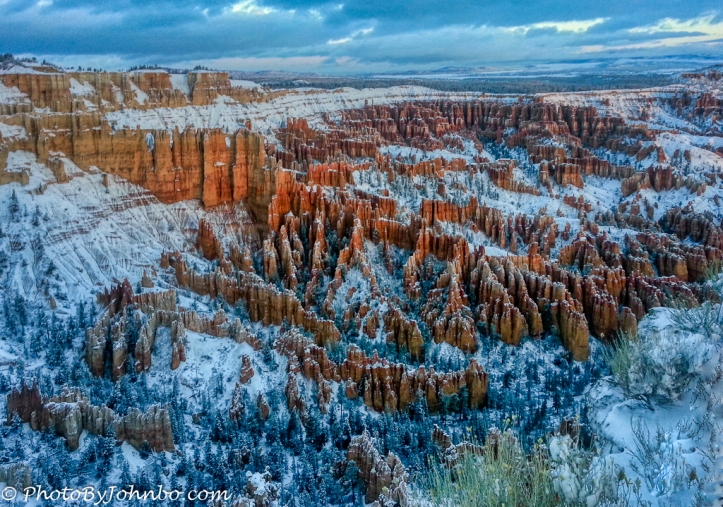In recent months, I’ve been learning some new processing tools, so I’ve been reviewing older photos that were originally rejected for one reason or another to give them another chance with new techniques now available to me. This image of Bryce Canyon was captured just before sunrise in October 2013 after an unexpected snowfall.
About the photo: The image was captured on a Samsung S3 cell phone but originally rejected for two major reasons. In the pre-dawn light it lacked contrast, the cloudy sky made it look gray and dull. In the lower right corner of the image, a guardrail meant to keep people like me from falling off the edge sneaked its way into the image. Using Photoshop Elements, I dealt with the fence. That tool is nowhere short of amazing at removing objects from a scene. That cliff edge at the lower right corner looks as natural as can be and there is no indication that I can see that it’s been doctored to remove a bit of chain link fence. Once the fence was gone, it took a pass through Aurora 2019 and and another through Luminar 2018 to add some punch to the image.
In most browsers, you can click on the image to enlarge it for a better view. The rule for Cellpic Sunday is simple. The image must be captured on a mobile device.
John Steiner

Spectacular! Great photo, John.
Thank you! I’m looking forward to sharing some reworked photos from earlier travels in this week’s photo challenge as well.
Nice Image, John. What new Photo techniques?
Les,
Until last year, I’ve used NIK photo tools to bring out details that I couldn’t seem to draw out from Lightroom. Those tools left too strong an appearance of that grungy HDR look. Early last year, I bought Luminar 2018 from Skylum Software and the tools in Luminar that I use most often are the Smart Tone and Accent AI filters. There are several other filters that I use regularly in Luminar to bring out details as well.
In late 2018, I added Skylum’s Aurora HDR tool. It merges my 3-image brackets much more realistically than NIK Tools and in almost all cases, it does at least as good a job as Lightroom in the merge process. It has the advantage of batch processing so I can select an entire folder of bracketed images and it organizes them into threes for bulk processing. I can then let the brackets merge in the background while I do other stuff, import them into Lightroom for cataloging and processing. Aurora has cut my time in front of the computer and I can spend more time processing images that have already been merged.
John – I also have Luminar 2018 and NIK Tools, plus. I found that using Luminar 2018 always puts my processed Image in a folder that does not seem to open right. I also have had Skylums Aurora HDR but did not seem to like it much. Maybe I just didn’t know how to use it better. Maybe I should. Be Well, John. I’m always watching.
Thanks. Interesting comment on the folder issue. I export the image from Lightroom v. 6 (the last version one could “own” from Adobe) and when I exit Luminar, it puts the photo back into the photo it came from.
Most of the tools in Aurora are duplicated in Luminar or simply “enhance” the HDR effect, something I don’t really like. I take the Aurora image after merging and tweak it in Lightroom and/or move it into Luminar for final tweaks. For me, Aurora is simply a batch processor for my 3-image brackets.
Thanks always, Les, for stopping by and commenting!
Anytime, John. BTW – I also use what’s called Photolemuir. It does a pretty good job.
I will have to check that one out!
Rural Utah is sooo beautiful, it’s too bad the cities are so weird…
I would like to visit Zion and Capital Reef parks one of these are days.